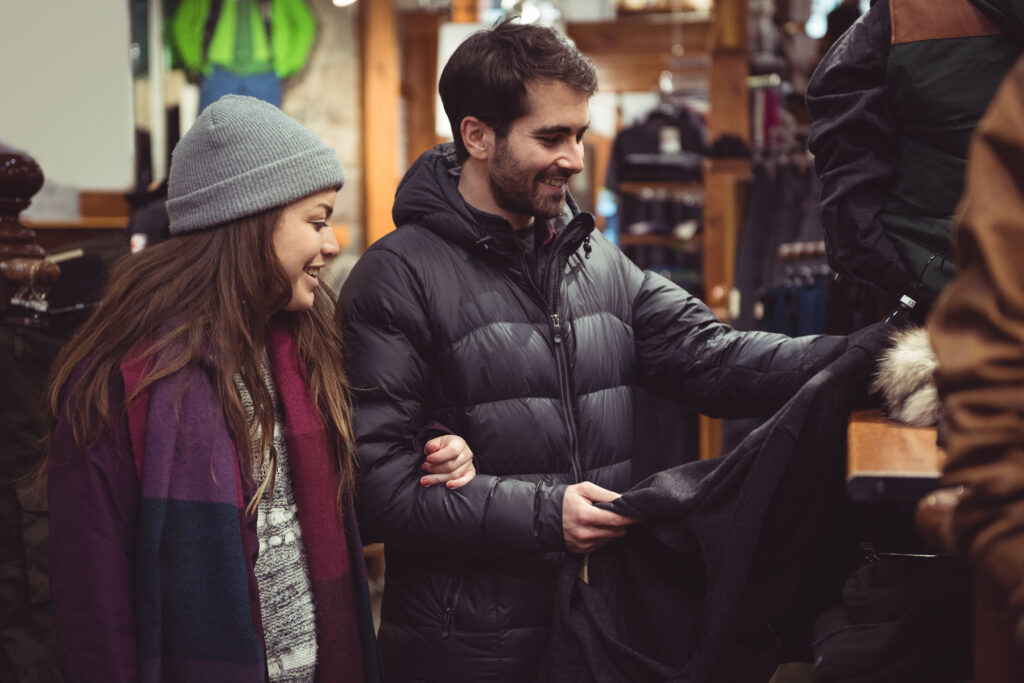
Couple selecting apparel together in a clothes shop
A leather jacket is more than clothing — it’s a personality statement, a weather shield, and, if cared for, an heirloom. In 2025, with sustainable fashion trending, maintaining your jacket keeps it looking sharp and reduces the need for replacement. This guide gives you practical, USA-friendly advice to keep your jacket in prime condition. Before this, explore variety of Leather Jackets in USA at Cuir Jackets here.
Know your leather
Not all leathers are created equal. Full-grain, top-grain, corrected-grain, suede, and nubuck each respond differently to cleaning and conditioning. Full-grain develops a beautiful patina with age; suede and nubuck are soft and require special brushing and protective sprays. Always check the manufacturer tag or product sheet for the leather type and care recommendations. If unsure, treat softly and test any product on a hidden seam or hem first.
Daily habits that add years
Hang your jacket on a broad, padded hanger to maintain angular shoulder shape. Avoid crumpling it in a car seat or stuffing it into a tight closet — leather needs to breathe. Don’t store it in plastic; instead use a cotton or canvas garment bag or breathable cover. After a wear, air the jacket indoors for an hour away from direct sunlight to let moisture evaporate. If you get caught in light rain, gently pat with a soft cloth and let it dry naturally. Avoid using heat sources like radiators or hairdryers, which may dry and crack the leather.
Cleaning basics
For everyday dust and dirt, use a dry microfiber or lint-free cloth, or a soft-bristled brush for suede. For smooth leather, a slightly damp cloth often suffices — wipe gently and follow with a dry cloth. For deeper cleaning, use a leather cleaner formulated for your leather type (smooth, aniline, suede, etc.). Apply a small amount to a cloth — never directly to the jacket — and work in gentle circular motions. Always perform a hidden spot test first. Avoid household cleaners, bleach, or harsh solvents; they strip natural oils, fade color, and may damage the finish.
Conditioning: the secret to suppleness
Leather behaves much like skin — it needs oils to stay flexible. Conditioning replenishes those oils and prevents drying, cracking, and stiffness. How often you condition depends on wear frequency and climate. In humid cities (e.g. Miami) you may condition less often than in arid regions (e.g. Phoenix). A guideline is every 3 to 6 months for smooth leather. Use a high-quality leather conditioner or cream, apply sparingly, and buff off any excess. For older jackets with stiff patches, a deeper conditioning session may help restore suppleness — but take care around dyes and finishes, as some conditioners can slightly darken leather.
Waterproofing and protection
Leather is naturally water-resistant but prolonged exposure to moisture can stain, stiffen, or warp it. Use a protective spray or wax suited for your specific leather type (smooth, suede, nubuck) to repel water and stains. These sprays are especially useful if you live in regions with heavy rain or snow (e.g. Pacific Northwest, Northeast). Reapply the protection annually or after any heavy cleaning. For salt stains from winter roads, gently wipe off dry residue with a damp cloth, then condition the area to restore oils.
Dealing with stains and spills
Time is of the essence. For oily stains, sprinkle cornstarch or talcum powder to absorb the oil; leave overnight, then brush off. Avoid rubbing hard. Ink stains often require professional attention; DIY attempts can worsen the spot. For water-ring marks, dampen the entire panel lightly and allow it to dry evenly, helping to equalize the appearance. When in doubt — especially with stubborn blemishes on a high-value jacket — consult a leather care professional to avoid irreversible damage.
Hardware, zippers, and small fixes
Metal hardware, snaps, and zippers deserve attention too. Keep zippers sliding smoothly by occasionally rubbing a bar of wax, candle, or clean soap along the teeth, then unzip and zip several times to distribute. If the slider sticks, gently work it free rather than forcing it. For tarnished snaps or buckles, use a soft cloth and mild metal polish, being careful to avoid contact with leather. For minor scuffs on smooth leather, a dab of conditioner and a gentle circular rub may reduce visibility. Loose threads can be trimmed carefully with fine scissors — but don’t tug. Replacing missing snaps or buttons can often be done with a basic sewing kit if you’re comfortable doing so.
Travel and commuting tips
When packing your leather jacket for travel, carry it on a wide hanger rather than folding it tightly in a suitcase. If folded, place it on top of other items so it isn’t crushed. During daily commutes, avoid slinging backpacks or straps across the same spot repeatedly — friction leads to wear and discoloration. On long flights, carry the jacket onboard and hang it in the plane closet if available; stowing it in overhead bins or under seats may cause creases or compression damage.
Storage: off-season strategies
Before long-term storage, clean and condition the jacket — applying oil before storage helps prevent drying and cracking. Store in a cool, dry, dark place away from pests. Use a wide-shouldered hanger and a breathable garment bag. Never vacuum-seal leather, and avoid cedar wood or mothballs, which can impart strong scents or damage finishes. If humidity is a concern, you may include silica gel packs (kept in pouches that don’t touch the leather) to help absorb excess moisture.
Seasonal care tips
- Winter: Protect from salt, slush, and snow. Wipe off residue promptly and reapply conditioner in early spring.
- Summer: Sun, heat, and UV rays can fade and dry leather. Store away from windows or direct sun, and apply conditioner to maintain oil balance. Be careful with sunscreen or deodorant — apply and let them dry before putting on your jacket.
- Transitional months (spring/fall): Use a lighter protective spray and condition every 4 to 6 weeks if the jacket is worn frequently.
Eco-friendly maintenance
In 2025, sustainable care is increasingly important. Choose biodegradable, plant-based cleaners and conditioners, avoiding parabens, silicones, and petroleum-derived chemicals. Many brands now offer eco-conscious leather care products. Opt to repair rather than replace — extending the life of your jacket reduces fashion waste. When possible, patronize local leather repair shops or artisans to minimize shipping emissions and support small businesses.
When to go professional
If your jacket shows widespread color loss, deep cracking, structural damage, or hardware failure, it’s time to consult a professional. Re-dyeing, full re-lining, or complex stitching should be left to experts who can match tone and preserve leather integrity. When choosing a specialist, ask for before-and-after photos, references, and experience with the particular type of leather in your jacket.
Common myths to avoid
Ignore quick-fix “tips” like using olive oil, coconut oil, or other household oils — they can darken, gum up, or degrade leather over time. Similarly, avoid DIY dyeing unless you have training — an uneven or mismatched result is hard to reverse. Don’t over-condition; heavy buildup may clog pores and attract dirt.
Pet hair and odor control
To remove pet hair, use a lint roller, a soft brush, or a damp microfiber cloth. For mild odors, hang the jacket outdoors (in shade) on a crisp day to air it out. If odors persist, have it professionally cleaned — overuse of deodorizers or fragrances can damage finishes.
Final thoughts
A leather jacket is a living garment — it will age, but with attentive care, it ages beautifully. The keys are consistent habits: clean gently, condition regularly, protect from water and heat, and store thoughtfully. In 2025, maintenance also means making sustainable product choices and emphasizing repair over replacement. Treat your jacket like an investment, and it will reward you with years of character, comfort, and unmistakable style. Small, regular care beats big, rare fixes — keep your jacket thriving year after.


